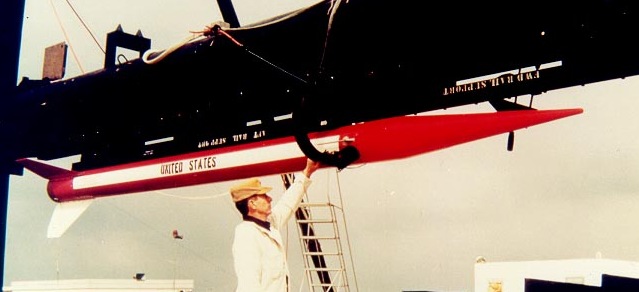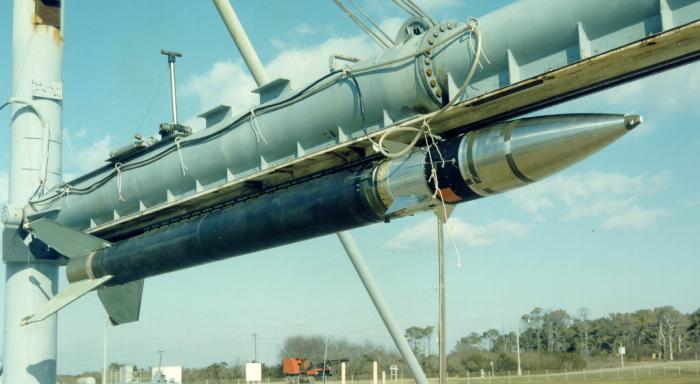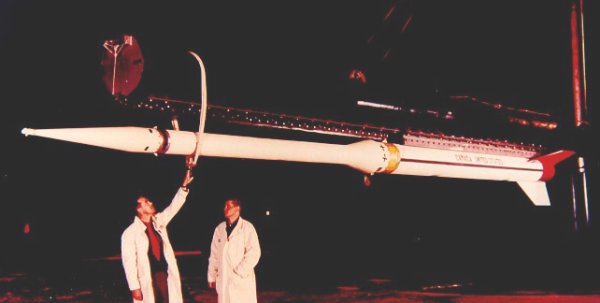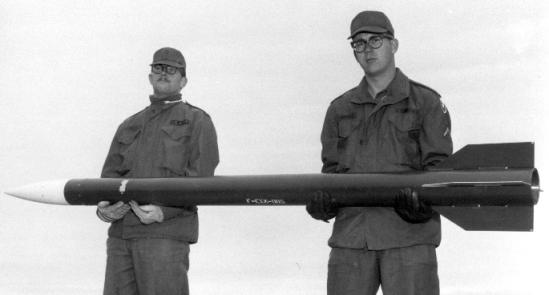Bristol of Canada Black Brant
Black Brant (frequently abbreviated to BB in this article) is the family name of a series of high-altitude sounding rockets designed by the Bristol of Canada company. Some examples were also used in low numbers by the U.S. military. To put these in proper context, however, the whole development history of the Black Brant series is briefly described.
Black Brant, Black Brant II
In 1958, a new solid rocket propellant was developed by the Canadian Armament Research and Development Establishment (CARDE). To test the new propellant, a propulsion test vehicle (PTV) was built by CARDE and Bristol. The PTV, which was flown 17 times, was eventually named Black Brant.
The success of the new propellant mix led to the development of a dedicated sounding rocket based on the Black Brant PTV. This was the Black Brant II (3 fins) and Black Brant IIA (4 fins). It could lift a payload of more than 100 kg (220 lb) to almost 200 km (125 miles) altitude. The NRCC (National Research Council Canada) flew about 60 BB IIs between 1960 and 1974.
Black Brant III, Black Brant IV, Black Brant V
In 1960, Bristol of Canada received a Canadian government contract to build a new series of sounding rockets for scientific purposes. To cover a wide range of performance, Bristol designed three different vehicles: the Black Brant V was an improved Black Brant II, the Black Brant III was a scaled-down rocket for smaller payloads in the lower atmospheric regions, and the Black Brant IV was a two-stage rocket, using a BB V as first and a BB III as second stage.
The Black Brant III first flew in June 1962, but because of initial problems with stability and control, it took until April 1964 that the rocket was declared ready for operations. It was a spin-stabilized vehicle, which could lift a 18 kg (40 lb) payload to 178 km (110 miles). The Black Brant IIIB was externally identical to the BB III, but used a new high-efficiency propellant. A total of at least 66 rockets if the Black Brant III type were fired until the last one in May 1985, primarily by Canadian scientists. The U.S. Navy tested the BB III twice in 1963, but did not adopt it for regular use. However, four more BB IIIs were launched by the Naval Research Lab between December 1965 and February 1966 to measure solar X-ray and UV radiation.
 |
| Photo: NASA, via Peter Alway |
| Black Brant III |
The Black Brant V was essentially a Black Brant II with an improved propellant, a lighter casing, smaller fins and a redesigned nose cone. It was designed to carry 70 kg (150 lb) to 320 km (200 miles). This version eventually became the Black Brant VB, while a variant with the BB II's propellant was labeled Black Brant VA. The Black Brant VC was a four-finned version of the BB VB. The BB VA first flew successfully in April 1964, but it was not before June 1965 that the ultimate BB VB lifted off for the first time. The BB V series was highly successful, and has been widely used by NASA, NRCC and other research organizations. More than than 200 rockets of this type have been fired so far, and NASA is still firing about one BB VB/VC per year. The U.S. Air Force's Cambridge Research Lab (AFCRL) has also launched more than 20 BB VA/VB/VC rockets, the last one in February 1974. The last USAF BB VC launch, an unidentified test mission, occurred in August 1996.
 |
| Photo: NASA, via Peter Alway |
| Black Brant VC * |
*Note: The small canards belong to a special payload with a guidance section controlling the initial ascent trajectory, and are not part of the standard BB V airframe.
The Black Brant IV's first stage was a BB VB with smaller fins. The BB III of the second stage had no fins and a new tail section to provide a rocket nozzle optimized for exoatmospheric flight. The first BB IV was launched in June 1964, but this flight, as well as the following one, was unsuccessful because the stage separation (using differential drag after first stage burnout) didn't work as designed. The separation mechanism was redesigned, and the third flight in January 1965 was finally successful. When the high-performance BB IIIB was used as upper stage, the BB IV became the Black Brant IVB. More than 50 BB IV-type rockets were launched until 1981, and altitudes of up to 800 km (500 miles) were reached. The USAF launched 8 BB IVs between 1969 and 1976.
 |
| Photo: NASA, via Peter Alway |
| Black Brant IV |
Black Brant VI, Black Brant VII
In 1967, Bristol of Canada received a U.S. Army development contract for a pair of small meteorological sounding rockets. The larger one became the Black Brant VI, while the smaller one was the Black Brant VII. The U.S. Army nomenclature for the BB VI was Weather Rocket, RDT&E, XM75. The BB VI's solid-propellant motor had a high initial thrust which gradually dropped until burnout. The four tail fins were canted to induce a stabilizing spin. At an apogee of about 75 km (47 miles), the nose cone was ejected, and a parachute opened under which the meteorological instrument package descended to the ground.
The BB VI was to be a cheap and reliable rocket. However, the development turned out to be much more costly than expected, and it took nearly 150 test firings by Bristol, before the U.S. Army accepted the XM75 rockets for its own evaluation. In the end, the Army abandoned the project in 1973 after only 7 launches, because the rockets were too expensive. A few BB VIs were eventually flown by Canadian scientists, the last one in April 1979.
 |
| Photo: Laurence Tulissi & Jason Wentworth, via Peter Alway |
| Black Brant VI |
The Black Brant VII was similar in concept to the BB VI, but was smaller and could reach an apogee of only 25 km (40 miles). Bristol fired more than 50 BB VIIs in tests from 1969, in which the payload ejection mechanism turned out to cause a lot of troubles. Because of the long development time, the BB VII became too expensive, just like the BB VI. The U.S. Army cancelled the BB VII program in 1972.
Black Brant 8
The Black Brant 8 (an arabic numeral appears to be favoured for this designation) was the combination of a BB V with a Nike booster. The Black Brant 8B had three fins on each stage, while the Black Brant 8C used four fins. The first flight of this model occurred in December 1975. More than 100 have been launched so far, and use of the BB 8C by NASA is continuing. The U.S. Air Force launched two BB 8Bs in September 1982 with ionosphere experiments, and two BB 8Cs in 1984 and 1987 with plasma experiment payloads.
Black Brant IX
The Black Brant IX was a BB V fitted with the booster of a surplus U.S. Navy RIM-2 Terrier missile. Starting in January 1982, almost 200 BB IXs have been launched so far, and use by NASA is continuing. The U.S. Air Force launched two of these rockets, in March 1985 and February 1987, with plasma experiment payloads.
Black Brant X, Black Brant XI, Black Brant XII
The BB X was a BB IX with a Nihka third stage, the BB XI was another three-stage rocket with a Talos, a Taurus and a BB VB stage, and the BB XII was a BB XI with a Nihka fourth stage. No examples of these models were launched by the U.S. military services.
Specifications
Note: Data given by several sources show slight variations. Figures given below may therefore be inaccurate!
Data for Black Brant III, IV, VC, VI, VII, 8C:
| Black Brant III | Black Brant IV | |
|---|---|---|
| Length ** | 5.46 m (17 ft 11 in) | 11.33 m (37 ft 2 in) |
| Fin Halfspan | 43.4 cm (17.1 in) | 62.5 cm (24.6 in) |
| Diameter | 25.9 cm (10.2 in) | 1st stage: 43.7 cm (17.2 in) 2nd stage: 25.9 cm (10.2 in) |
| Weight * | 300 kg (660 lb) | 1500 kg (3300 lb) |
| Altitude ** | 178 km (110 miles) | 800 km (500 miles) |
| Propulsion † | "Black Brant III" motor; 49 kN (11000 lb) for 9 s | 1st stage: "Black Brant VC" motor; 76 kN (17000 lb) for 27 s 2nd stage: "Black Brant III" motor; 49 kN (11000 lb) for 9 s |
| Black Brant VC | Black Brant VI | |
|---|---|---|
| Length ** | 7.84 m (25 ft 8.5 in) | 2.81 m (9 ft 2.8 in) |
| Finspan | 1.51 m (59.6 in) | 30.2 cm (11.9 in) |
| Diameter | 43.8 cm (17.3 in) | 12.4 cm (4.9 in) |
| Weight * | 1200 kg (2650 lb) | 48 kg (105 lb) |
| Altitude ** | > 250 km (155 miles) | 75 km (47 miles) |
| Propulsion † | "Black Brant VC" motor; 76 kN (17000 lb) for 27 s | "Black Brant VI" motor; 5.8 kN (1300 lb) (avg.) for 8.8 s |
| Black Brant VII | Black Brant 8C | |
|---|---|---|
| Length ** | 2.06 m (6 ft 9 in) | 11.34 m (37 ft 2.5 in) |
| Finspan | 19.1 cm (7.53 in) | 1st stage: 1.53 m (60.1 in) 2nd stage: 1.51 m (59.6 in) |
| Diameter | 8.95 cm (3.53 in) | 1st stage: 41.9 cm (16.5 in) 2nd stage: 43.8 cm (17.3 in) |
| Weight * | 16.8 kg (37 lb) | 2000 kg (4400 lb) |
| Altitude ** | 40 km (25 miles) | > 340 km (210 miles) |
| Propulsion † | "Black Brant VII" motor; 1 kN (225 lb) for 4 s | 1st stage: ABL M5 Nike; 246 kN (55000 lb) for 3 s 2nd stage: "Black Brant VC" motor; 76 kN (17000 lb) for 27 s |
** With typical payloads
† All stages are solid-propellant rockets
Main Sources
[1] Peter Alway: "Rockets of the World", Saturn Press, 1999
[2] Peter Alway: "Rockets of the World, 1999 Supplement", Saturn Press, 1999
[3] Peter Alway: "Rockets of the World, 2000 Supplement", Saturn Press, 2000
[4] Peter Alway: "Rockets of the World, 2003 Supplement", Saturn Press, 2003
[5] Jonathan McDowell: Launch Vehicles Database
Back to Directory of U.S. Military Rockets and Missiles, Appendix 4
Last Updated: 17 February 2005